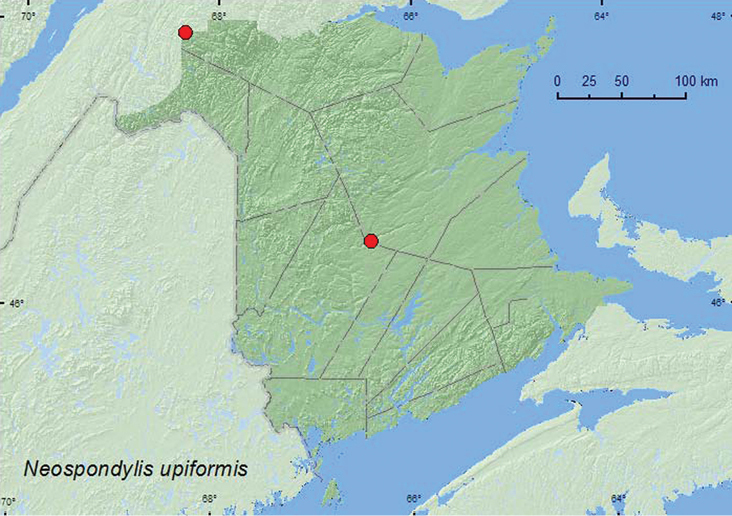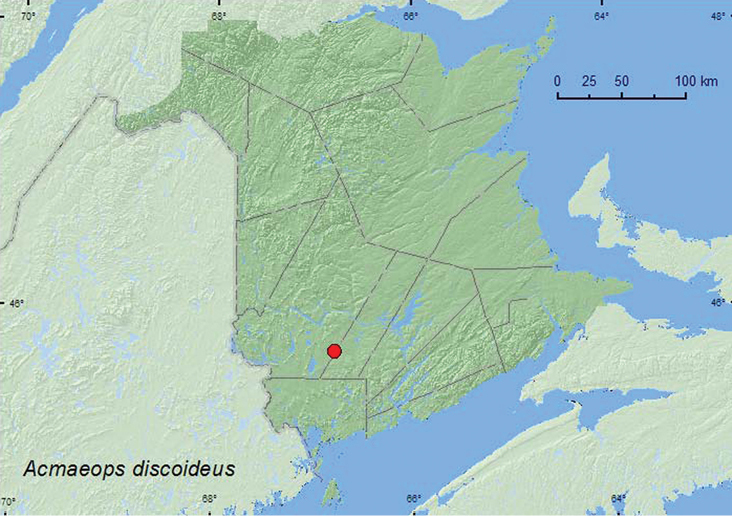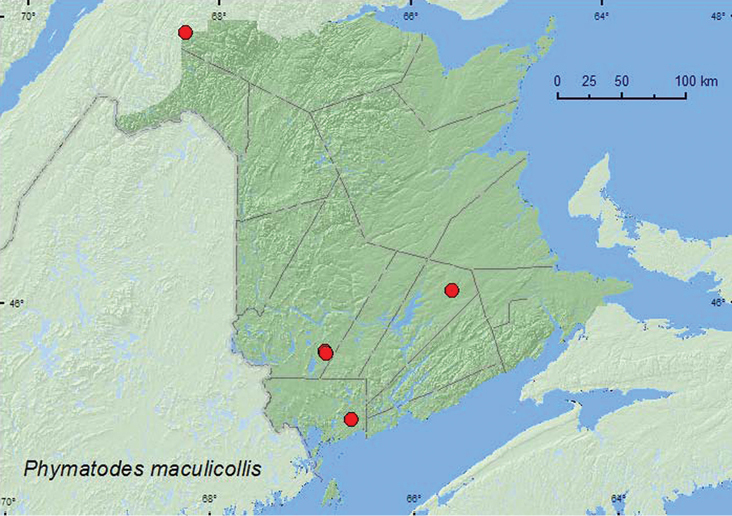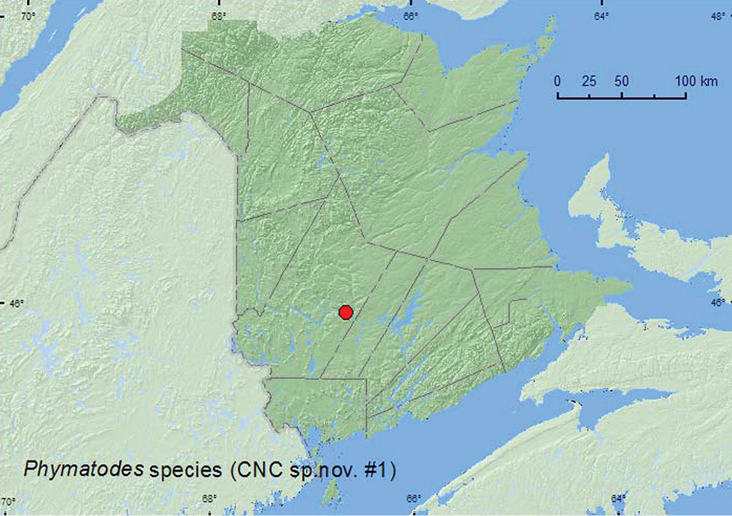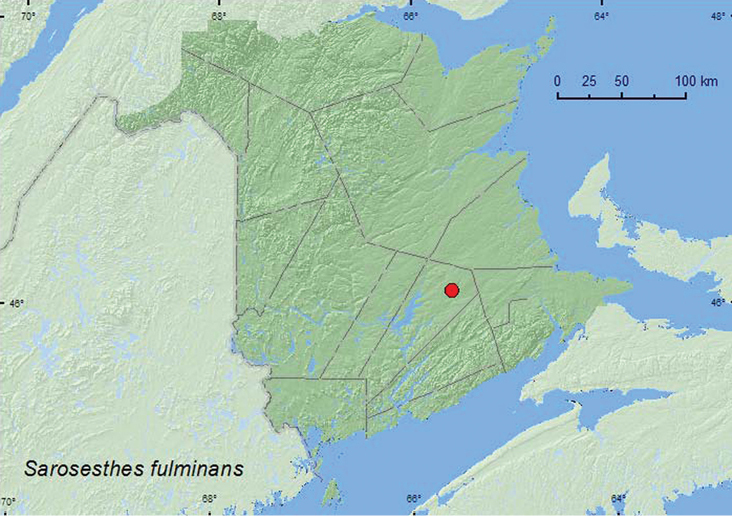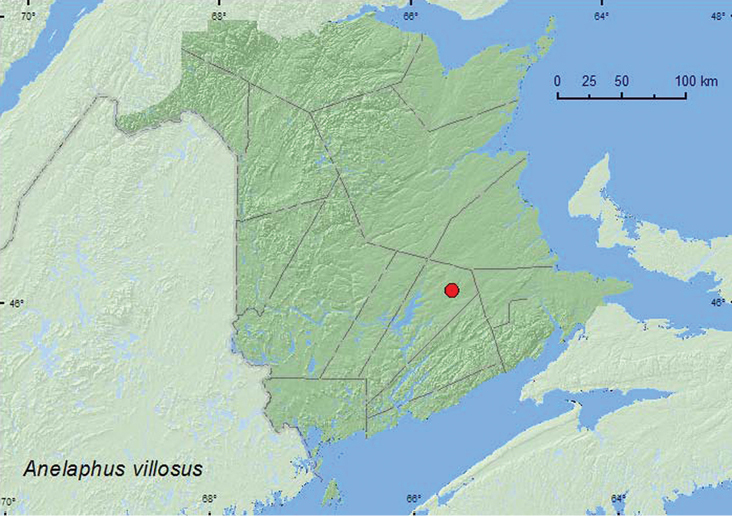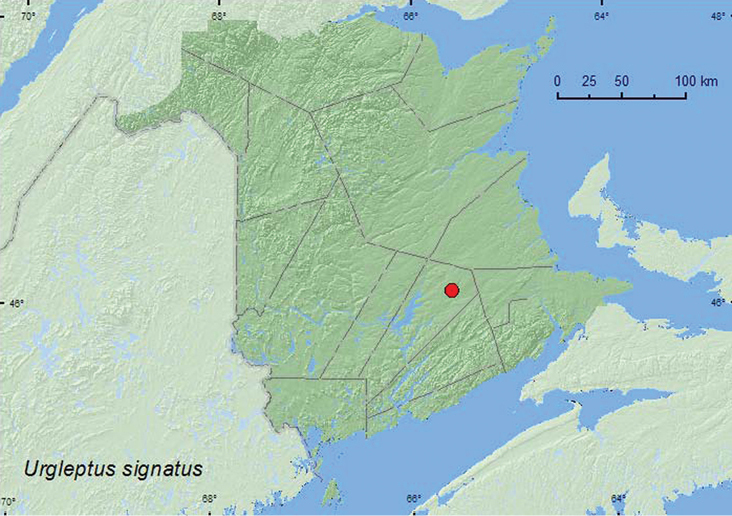ZooKeys 179: 309–319, doi: 10.3897/zookeys.179.2601
New Coleoptera records from New Brunswick, Canada: Cerambycidae
Reginald P. Webster 1, Jon D. Sweeney 1, Ian DeMerchant 1, Peter J. Silk 1, Peter Mayo 1
1 Natural Resources Canada, Canadian Forest Service - Atlantic Forestry Centre, 1350 Regent St., P.O. Box 4000, Fredericton, NB, Canada E3B 5P7
Abstract
Five species of Cerambycidae, Acmaeops discoideus (Haldeman), Anelaphus villosus (Fabricius), Phymatodes species (CNC sp. n. #1), Sarosesthes fulminans (Fabricius), and Urgleptus signatus (LeConte) are newly recorded for New Brunswick, Canada. All but Acmaeops villosus are new to the Maritime provinces. Phymatodes testaceus (Linnaeus) is removed from the faunal list of the province as a result of mislabeled specimens, records of Phymatodes maculicollis LeConte are presented confirming the presence of this species in New Brunswick, and the first recent records ofNeospondylis upiformis (Mannerheim) are presented. Additional records are given for the recently recorded Phymatodes aereus (Newman), indicating a wider distribution in the province. Collection data, habitat data, and distribution maps are presented for each species.
KeywordsCerambycidae, new records, Canada, New Brunswick
Introduction
The Cerambycidae (longhorn beetles) fauna of New Brunswick and the Maritime provinces (New Brunswick, Nova Scotia, Prince Edward Island) were reviewed by McCorquodale and Bondrup-Nielsen (2004) and Webster et al. (2009). Majka et al. (2007) reviewed the fauna of Prince Edward Island. Later, McCorquodale (2010) reviewed the longhorn beetle fauna of the Atlantic Maritime Ecozone in the context of collections and sources of information, the geographic distribution within the ecozone and overall global distribution, host plant usage, and anthropogenic effects on the fauna. Webster et al. (2009) reported 48 species as new to the province, bringing the total number of species known from New Brunswick to 116. More recently, Majka et al. (2010) added Phymatodes aereus (Newman) and Typocerus sparsus LeConte to the faunal list. Here, we add six species of Cerambycidae to the faunal list of New Brunswick.
Methods and conventions
Collection methods
Most specimens were collected from Lindgren funnel trap samples during a study to develop a general attractant for the detection of invasive species of Cerambycidae. These traps mimic tree trunks and are often effective for sampling species of Coleoptera that live in microhabitats associated with standing trees (Lindgren 1983). [See Webster et al. (in press) for details of the methods used to deploy Lindgren 12-funnel traps and for sample collection.] Traps were baited with commercially purchased high-release-rate lures of ethanol, α-pinene (mixture of 93% (-) and 7% (+) α-pinene), or “BSLB kairomone” (Contech International, Inc.; a blend of monoterpenes attractive to Tetropium fuscum (Fabr.) and Tetropium cinnamopterum Kirby) (Sweeney et al. 2006) or with racemic 3-hydroxyhexan-2-one or racemic 3-hydroxyoctan-2-one, synthesized at the Fredericton laboratory (See Hanks et al. (2007) and reference therein for details on their synthesis) and loaded into release devices by Contech International, Inc. (Delta BC). Specific enantiomers of the latter compounds have been identified as long-distance sex/aggregation pheromones in several species of Cerambycinae (Fettköther et al. 1995; Leal et al. 1995; Lacey et al. 2004, 2007). The pheromones are naturally emitted by males and attract females or both sexes depending on the species (Lacey et al. 2004, 2007; Hanks et al. 2007). A description of the habitat was recorded for all specimens collected during this survey. Locality and habitat data are presented exactly as on labels for each record. This information, as well as additional collecting notes, is summarized and discussed in the collection and habitat data section for each species.
Distribution
Distribution maps, created using ArcMap and ArcGIS, are presented for each species in New Brunswick. Every species is cited with current distribution in Canada and Alaska, using abbreviations for the state, provinces, and territories. New records for New Brunswick are indicated in bold under Distribution in Canada and Alaska. The following abbreviations are used in the text:
Acronyms of collections examined or where specimens reside referred to in this study are as follows:
AFC Atlantic Forestry Centre, Natural Resources Canada, Canadian Forest Service, Fredericton, New Brunswick, Canada
CNC Canadian National Collection of Insects, Arachnids and Nematodes, Agriculture and Agri-Food Canada, Ottawa, Ontario, Canada
NBM New Brunswick Museum, Saint John, New Brunswick, Canada
RWC Reginald Webster Collection, Charters Settlement, New Brunswick, Canada
|
AK
|
Alaska |
MB
|
Manitoba |
|
YT
|
Yukon Territory |
ON
|
Ontario |
|
NT
|
Northwest Territories |
QC
|
Quebec |
|
NU
|
Nunavut |
NB
|
New Brunswick |
|
BC
|
British Columbia |
PE
|
Prince Edward Island |
|
AB
|
Alberta |
NS
|
Nova Scotia |
|
SK
|
Saskatchewan |
NF & LB
|
Newfoundland and Labrador* |
* Newfoundland and Labrador are each treated separately under the current Distribution in Canada and Alaska.
Results
Species accounts
All records below are species newly recorded for New Brunswick, Canada, unless noted otherwise (additional records). Species followed by ** are newly recorded from the Maritime provinces of Canada.
Family Cerambycidae Latreille, 1802
Subfamily Spondylidinae Audinet-Serville, 1832
Tribe Spondylidini Audinet-Serville, 1832
Material examined.
Additional New Brunswick records, Restigouche Co., Dionne Brook P.N.A. (Protected Natural Area), 47.9064°N, 68.3441°W, 31.V–15.VI.2011, 27.VI–14.VII.2011, M. Roy & V. Webster, old-growth white spruce and balsam fir forest, Lindgren funnel traps (5, AFC, NBM, RWC).
Collection and habitat data. Adults were captured in Lindgren funnel traps deployed in an old-growth white spruce (Picea glauca (Moench) Voss) and balsam fir (Abies balsamea (L.) Mill.) forest. Specimens were captured during June and July in New Brunswick. Larvae of this species probably feed in the roots of fir (Abies) or pine (Pinus) (Yanega 1996).
Distribution in Canada and Alaska. AK, BC, AB, ON, QC, NB, NS, NF (McNamara 1991; Smith and Hurley 2006; Webster et al. 2009; Majka and Ogden 2010). Webster et al. (2009) newly reported this species from New Brunswick based on a specimen collected by Charles E. Atwood in Boiestown, Northumberland Co. (specimen is in the Royal Ontario Museum, Toronto). No date was given on the label, but Charles Atwood made a few collecting trips to New Brunswick during the 1930s (McCorquodale 2010). The record from the Dionne Brook P.N.A. is the first recent record of this species from the province.
Map 1.
Collection localities in New Brunswick, Canada of Neospondylis upiformis.
Material examined.
New Brunswick, York Co., 8.1 km W of Tracy off Rt. 645, 45.6880°N, 66.7841°W, 30.VI.2010, R. P. Webster, roadside, on Sambucus canadensis flowers (1, RWC).
Collection and habitat data.
One individual was collected in late June from flowers of elderberry (Sambucus canadensis L.) on a roadside near an area with red pine (Pinus resinosa Ait.) and white pine (Pinus strobus L.). The larvae of this species develop in Pinus spp. (Yanega 1996).
Distribution in Canada and Alaska. NB, NS (Webster et al. 2009). Webster et al. (2009) newly recorded this species from Canada on the basis of a specimen collected in Halifax, Nova Scotia.
Map 2.
Collection localities in New Brunswick, Canada of Acmaeops discoideus.
Material examined.
Additional New Brunswick records. Queens Co., Cranberry Lake P.N.A, 46.1125°N, 65.6075°W, 27.V–5.VI.2009, 11–18.VI.2009, 18–25.VI.2009, 25.VI–1.VII.2009, 7–14.VIII.2009, R. Webster & M.-A. Giguère, old red oak forest, Lindgren funnel traps (37, AFC, RWC); same locality and forest type, 22–29.VI.2011, 29.VI–7.VII.2011, M. Roy & V. Webster, old red oak forest, Lindgren funnel traps (4, AFC, NBM); Grand Lake Meadows P.N.A., 45.8227°N, 66.1209°W, 31.V–15.VI.2009, 15–29.VI.2009, R. Webster & C. MacKay, old silver maple forest with green ash and seasonally flooded marsh, Lindgren funnel traps (10, AFC); same locality data and forest type, 29.VI-12.VII.2009, R. Webster, C. MacKay, M. Laity, & R. Johns, Lindgren funnel trap (1, AFC). York Co., 15 km W of Tracy off Rt. 645, 45.6848°N, 66.8821°W, 7–14.VII.2009, R. Webster & M.-A. Giguère, old red pine forest, Lindgren funnel traps (1, RWC).
Collection and habitat data.
Phymatodes aereus was captured in Lindgren funnel traps baited with racemic 3-hydroxyhexan-2-one deployed in an old red oak (Quercus rubra L.) forest, an old silver maple (Acer saccharinum L.) forest, and in an old red pine forest with scattered hardwoods. Larvae of this uncommon species develop in dead Quercus (Lingafelter 2007). Adults in New Brunswick were captured during May, June, and July.
Distribution in Canada and Alaska.
ON, QC, NB (McNamara 1991; Majka et al. 2010). Majka et al. (2010) newly recorded this species from New Brunswick and the Maritime provinces, based on a specimen collected by Martin Turgeon in Saint-Basile, Madawaska Co. during 2003. This species is probably widespread in the province.
Map 3.
Collection localities in New Brunswick, Canada of Phymatodes aereus.
Material examined.
Additional New Brunswick records. Charlotte Co., 10 km NW of New River Beach, 45.2110°N, 66.6170°W, 15–29.VI.2010, R. Webster & C. MacKay, old growth eastern white cedar forest, Lindgren funnel trap (1, AFC). Queens Co., Cranberry Lake P.N.A, 46.1125°N, 65.6075°W, 27.V-5.VI.2009, 18–25.VI.2009, R. Webster & M.-A. Giguère, old red oak forest, Lindgren funnel trap (2, AFC, RWC). Restigouche Co., Dionne Brook P.N.A., 47.9064°N, 68.3441°W, 27.VI-14.VII.2011, 14–28.VII.2011, M. Roy & V. Webster, old-growth white spruce and balsam fir forest, Lindgren funnel traps (6, AFC, NBM, RWC). York Co., 15 km W of Tracy off Rt. 645, 45.6848°N, 66.8821°W, 21–28.VI.2009, R. Webster & M.-A. Giguère, old red pine forest, Lindgren funnel traps (1, RWC); 14 km WSW of Tracy, S of Rt. 645, 45.6741°N, 66.8661°W, 10–26.V.2010, 2–16.VI.2011, R. Webster & C. MacKay, old mixed forest with red and white spruce, red and white pine, balsam fir, eastern white cedar, red maple, and Populus sp., Lindgren funnel trap (14, AFC, RWC).
Collection and habitat data.
Phymatodes maculicollis larvae develop under bark of spruce (Picea) and fir branches (Yanega 1996). This species, which is considered rare in the East, was captured in Lindgren funnel traps baited with racemic 3-hydroxyhexan-2-one deployed in an old-growth eastern white cedar (Thuja occidentalis L.) forest, an old-growth white spruce and balsam fir forest, an old red pine forest, an old mixed forest, and in an old red oak forest with scattered conifers. Adults were captured during May, June, and July.
Distribution in Canada and Alaska.
YK, BC, QC, NB (McNamara 1991). McNamara (1991) listed Phymatodes maculicollis for New Brunswick but no supporting voucher specimens or other published records could be located by Webster et al. (2009). The above records establish the presence of this species for the province.
Map 4.
Collection localities in New Brunswick, Canada of Phymatodes maculicollis.
Phymatodes species
(CNC sp. n. #1)**
Map 5
Material examined.
New Brunswick, York Co., (Fredericton) Odell Park, 2.VII.2002, (G. Smith) Trap Lindgren Funnel, Lure Ipslure (1, AFC).
Collection and habitat data.
One individual was captured during July in a Lindgren funnel trap in an old-growth forest with hemlock (Tsuga canadensis (L.) Carr.), American beech (Fagus grandifolia Ehrh.), and sugar maple (Acer saccharum Marsh.).
Distribution in Canada and Alaska.
QC, NB (Yanega 1996). According to Yanega (1996)this undescribed species is related to Phymatodes ater LeConte but lacks the prominent pronotal calli and possesses finer elytral punctures.
Map 5.
Collection localities in New Brunswick, Canada of Phymatodes species (CNC sp. n. #1).
Webster et al. (2009) reported Phymatodes testaceus from New Brunswick based on a series of specimens collected from Pleasantfield in Queens Co. There are no towns with this name in Queens Co., New Brunswick. The original Forest Insect and Disease Survey slip (at AFC) was examined and Pleasantfield is actually in Queens Co., Nova Scotia, indicating that these specimens had been mislabeled. Phymatodes testaceus is accordingly removed from the faunal list of New Brunswick.
Material examined.
New Brunswick, Queens Co., Cranberry Lake P.N.A, 46.1125°N, 65.6075°W, 11–18.VI.2009, 18–25.VI.2009, 25.VI–1.VII.2009, 15–21.VII.2009, 19.VIII-2.IX.2009, R. Webster & M.-A. Giguère, old red oak forest, Lindgren funnel traps (59, AFC, NBM, RWC); same locality and forest type, 29.VI–7.VII.2011, 20.VII–4.VIII.2011, M. Roy & V. Webster, old red oak forest, Lindgren funnel traps (4, AFC, NBM).
Collection and habitat data.
All Sarosesthes fulminans specimens but one were captured in Lindgren funnel traps baited with racemic 3-hydroxyhexan-2-one. Lacey et al. (2009) showed that males of this species emit (R)-3-hydroxyhexan-2-one and (2S, 3R)-2, 3-hexane-diol and that both sexes were attracted to males in laboratory olfactometer bioassays. Adults were collected in an old red oak forest during June, July, and August. Larvae of this uncommon species occur under bark and in sapwood of oak and other hardwood species (Yanega 1996; Lingafelter 2007).
Distribution in Canada and Alaska.
ON, QC, NB (McNamara 1991). This species was abundant at the Cranberry Lake P.N.A. (Protected Natural Area) and will probably be found at other localities in New Brunswick and the other Maritime provinces where red oak occurs using traps baited with racemic 3-hydroxyhexan-2-one.
Map 6.
Collection localities in New Brunswick, Canada of Sarosesthes fulminans.
Material examined.
New Brunswick, Queens Co., Cranberry Lake P.N.A, 46.1125°N, 65.6075°W, 29.VI–7.VII.2011, 13–20.VII.2011, 20.VII–4.VIII.2011, 4–18.VIII.2011, M. Roy & V. Webster, old red oak forest, Lindgren funnel traps in forest canopy (7, AFC, NBM, RWC).
Collection and habitat data.
Adults were captured during July and August in Lindgren funnel traps baited with ethanol deployed in the forest canopy of an old red oak forest. Larvae are twig pruners of most eastern hardwoods and shrubs (Lingafelter 2007).
Distribution in Canada and Alaska.
MB, ON, QC, NB, NS (McNamara 1991; McCorquodale and Bondrup-Nielsen 2004).
Map 7.
Collection localities in New Brunswick, Canada of Anelaphus villosus.
Material examined.
New Brunswick, Queens Co., Cranberry Lake P.N.A, 46.1125°N, 65.6075°W, 29.VI–7.VII.2011, 13–20.VII.2011, 20.VII–4.VIII.2011, M. Roy & V. Webster, old red oak forest, Lindgren funnel traps in forest canopy (3, NBM, RWC); same locality data and forest type, 31.VIII–15.IX.2011, R. P. Webster & Cory Hughes, Lindgren funnel trap in forest canopy (1, AFC).
Collection and habitat data.
This species was captured in Lindgren funnel traps baited with ethanol deployed in the canopy of an old red oak forest. Adults were collected during July, August, and September. Larvae live in branches of various hardwoods, such as Acer, Cornus, Quercus, and Tilia (Lingafelter 2007).
Distribution in Canada and Alaska.
ON, QC, NB (McNamara 1991).
Map 8.
Collection localities in New Brunswick, Canada of Urgleptus signatus.
Acknowledgments
We thank Caroline Simpson for editing this manuscript and Serge Laplante (Agriculture and Agri-Food Canada (CNC), Ottawa) for determining species and other invaluable assistance. Two anonymous reviewers are thanked for their helpful suggestions that improved this manuscript. Nichole Brawn, Katie Burgess, Marie-Andrée Giguère, Nancy Harn, Cory Hughes, Rob Johns, Marsell Laity, Colin MacKay, Wayne MacKay, Jessica Price, Michelle Roy, and Vincent Webster are thanked for technical assistance and collecting specimens. We thank Natural Resources Canada, Canadian Forest Service; the Canadian Food Inspection Agency; and the USDA APHIS for funding the study on early detection of invasive cerambycids, which provided many specimens collected in Lindgren funnel traps. The New Brunswick Wildlife Trust Fund is thanked for funding various insect surveys over the past 7 years. The New Brunswick Department of Natural Resources (Fish and Wildlife Branch) is thanked for issuing permits for sampling in the Protected Natural Areas.
ReferencesFettköther R, Dettner K, Schröder F, Meyer H, Franke W, Noldt U (1995) The male pheromone of the old house borer
Hylotrupes bajulus (L.) (Coleoptera: Cerambycidae): identification and female response. Experientia 51: 270-277. doi:
10.1007/BF01931111
Hanks LM, Millar JG, Moreira JA, Barbour JD, Lacey ES, McElfresh JS, Reuter FR, Ray AM (2007) Journal of Chemical Ecology 33: 889-907. doi:
10.1007/s10886-007-9275-4
Lacey ES, Ginzel MD, Millar JG, Hanks LM (2004) Male-produced aggregation pheromone of the cerambycid beetle
Neoclytus acuminatus acuminatus. Journal of Chemical Ecology 30: 1493-1507. doi:
10.1023/B:JOEC.0000042064.25363.42
Lacey ES, Millar JG, Moreira JA, Hanks LM (2009) Male-produced aggregation pheromones of the cerambycid beetles
Xylotrechus colonus and
Sarosesthes fulminans. Journal of Chemical Ecology 35: 733-740. doi:
10.1007/s10886-009-9633-5
Leal WS, Shi X, Nakamuta K, Ono M, Meinwald J (1995) Structure, stereochemistry, and thermal isomerization of the male sex pheromone of the longhorn beetle
Anaglyptus subfasciatus. Proceedings of the National Academy of Science, USA. 92: 1038-1042. doi:
10.1073/pnas.92.4.1038
Lindgren BS (1983) A multiple funnel trap for scolytid beetles (Coleoptera). The Canadian Entomologist 115: 299-302. doi:
10.4039/Ent115299-3
Lingafelter SW (2007) Illustrated key to the longhorned woodboring beetles of the eastern United States. Special Publication No. 3, Coleopterists Society, North Potomac, Maryland, USA, 2007, 206 pp.
Majka CG, McCorquodale DB, Smith ME (2007) The Cerambycidae (Coleoptera) of Prince Edward Island: new records and further lessons in biodiversity. The Canadian Entomologist 139: 258-268. doi:
10.4039/n06-051
Majka CG, Migneault R, Turgeon M (2010) Additions to the Cerambycidae (Coleoptera) fauna of the Maritime provinces of Canada. Journal of the Acadian Entomological Society 6: 25-27.
Majka CG, Ogden J (2010) New Records of Cerambycidae in Nova Scotia. Journal of the Acadian Entomological Society 6: 12-15.
McCorquodale DB (2010) Longhorn beetles (Coleoptera: Cerambycidae) of the Atlantic Maritime Ecozone In: McAlpine DF, Smith IM (Eds). Assessment of Species Diversity in the Atlantic Maritime Ecozone. NRC Research Press, Ottawa, Ontario, Canada: 465-476.
McCorquodale DB, Bondrup-Nielsen (2004) Do we know beetles? Lessons and new records of Cerambycidae (Coleoptera) for Nova Scotia. Proceedings of the Nova Scotia Institute of Science 42: 209-223.
McNamara J (1991) Family Cerambycidae: longhorned beetles. In: Bousquet Y (Ed). Checklist of Beetles of Canada and Alaska. Publication 1861/E, Agriculture Canada, Research Branch, Ottawa, Ontario: 277-300.
Smith GA, Hurley JE (2006) First records in Atlantic Canada of
Spondylis unpiformis Mannerheim and
Xylotrechus sagittatus sagittatus (Germar) (Coleoptera: Cerambycidae). The Coleopterists Bulletin 59: 488. doi:
10.1649/836.1
Sweeney JD, Gutowski JM, Price J, de Groot P (2006) Effect of semiochemical release rate, killing agent, and trap design on detection of
Tetropium fuscum (F.) and other longhorn beetles (Coleoptera: Cerambycidae). Environmental Entomology 35: 645-654. doi:
10.1603/0046-225X-35.3.645
Webster RP, McCorquodale DB, Majka CG (2009) New records of Cerambycidae (Coleoptera) for New Brunswick, Nova Scotia, and Prince Edward Island, Canada. In: Majka CG, Klimaszewski J (Eds). Biodiversity, biosystematics, and ecology of Canadian Coleoptera II. ZooKeys 22: 285–308. doi:
10.3897/zookeys.22.122
Webster RP, Smetana A, Sweeney JD, DeMerchant I (in press) New Staphylinidae (Coleoptera) records with new collection data from New Brunswick and an addition to the fauna of Quebec: Staphylininae. In: Klimaszewski J, Anderson R (Eds) Biodiversity, Biosystematics and Ecology of Canadian Staphylinidae (Coleoptera) II. ZooKeys.
Yanega D (1996) Field guide to northeastern long-horned beetles (Coleoptera: Cerambycidae), Illinois Natural History Survey Manual 6, Champaign, Illinois. 174 pp.







